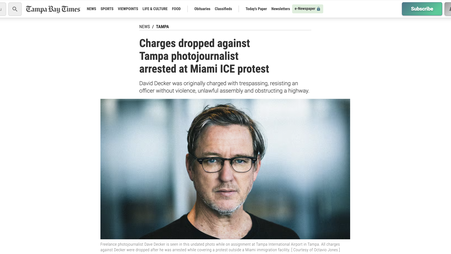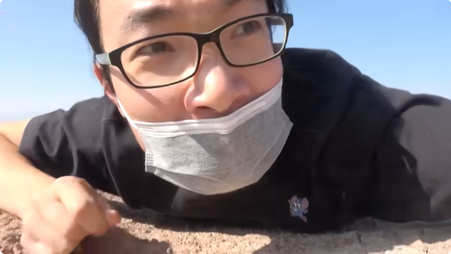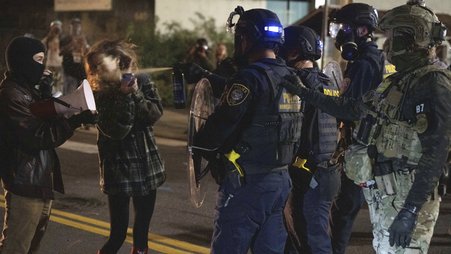We wrote last week about the Chicago Police Department’s “abysmal failure” to respect journalists’ rights during protests outside the Democratic National Convention.
We followed that up this week with an Aug. 26 “X Space” conversation featuring Mickey Osterreicher, general counsel for the National Press Photographers Association, and Katherine Jacobsen, the Committee to Protect Journalists’ U.S. and Canada program coordinator.
Jacobsen attended the convention, while Osterreicher worked with local lawyers to free journalists arrested covering protests.
On the inside
Jacobsen noted that protests were audible from the convention hall, and commented on the “jarring contrast” between the protests outside and the “very scripted programming” inside. That may have been good news for demonstrators, who weren’t sure whether they could be heard from the highly contested protest route.
Jacobsen commented on the widely reported chaos for journalists and others attempting to get through security and into the convention hall, as well as the high cost for journalists to obtain basic workspaces and internet connectivity at the convention: “It's really unfortunate that the cost was so high because it does make it so much more difficult for local news outlets to be able to cover something that is … of national, international importance that's happening in their own community.”
Social media influencers, on the other hand, were given “great access” and “nicer facilities” while journalists were “packed into the press section like sardines most nights,” said Jacobsen.
Asked if the convention gave any indication of whether the Harris campaign would make itself more accessible to the media going forward, Jacobsen said it was difficult to tell. But she pushed back against false contrasts between Harris and her opponent, Donald Trump, when it comes to interactions with the press.
“Access doesn't necessarily equate to quality discussion,” she said. “What kind of interactions does the media get from Trump? And are those constructive for furthering political discourse?” she asked. “Should there be more access from the Democrats? Absolutely, going forward. I hope we see that. But are all the criticisms of saying, you know, that Trump has granted so much more access than the Democrats have? Well, sure. But to what end?”
In the streets
Osterreicher said he, along with the Reporters Committee for Freedom of the Press, had trained Chicago police on press freedom at protests prior to past major events. They also trained Milwaukee police prior to this year’s Republican National Convention.
But this time, Chicago officials said they’d conducted their own First Amendment training and did not need any outside help. Turns out they did — they repeatedly dispersed law-abiding journalists along with protesters, depriving them of the ability to cover police conduct. “As we've seen through a number of previous court cases over the years, especially during the Black Lives Matter protests, … the courts ruled that journalists are not participants” in unlawful assemblies and therefore not subject to dispersal, Osterreicher explained.
Tom Ahern, the Chicago Police Department’s deputy director of news affairs and communications, repeatedly threatened to confiscate press passes from journalists who didn’t abide by his unconstitutional dispersal orders, and in at least one instance reportedly ripped a press pass away from a journalist.
In addition to those dispersed, the U.S. Press Freedom Tracker, a project of Freedom of the Press Foundation (FPF), has reported the arrests of three journalists, and is researching more potential cases. Osterreicher said police had committed to avoid detaining journalists and instead issue citations so the journalists could get back to doing their job. They didn’t honor that commitment.
By arresting them and keeping them detained for hours, he said, police imposed a “constructive prior restraint, because these journalists have been taking pictures … and because they were in custody, they couldn't get those pictures out to their news outlets.”
Jacobsen agreed, citing “the newsgathering that was lost by having reporters … removed from the scene.” As a result, she said, “We don't have documentation of what happened from certain hours,” particularly when police dispersed protesters.
Police often argue that, especially these days when anyone with a phone can report news, it’s impossible to distinguish between journalists and protesters. Adding to that, some journalists intentionally try to blend in to avoid making themselves targets. Osterreicher said, in the absence of bright-line tests, officers should assume someone acting like a journalist is one.
“Just as our criminal justice system works as we would rather let 99 guilty people go free than convict one innocent person, assume that they're journalists and let them do their jobs” he added.
Even if you don't use X, you can listen to the full conversation, and read an (AI generated and imperfect) transcript, here.





